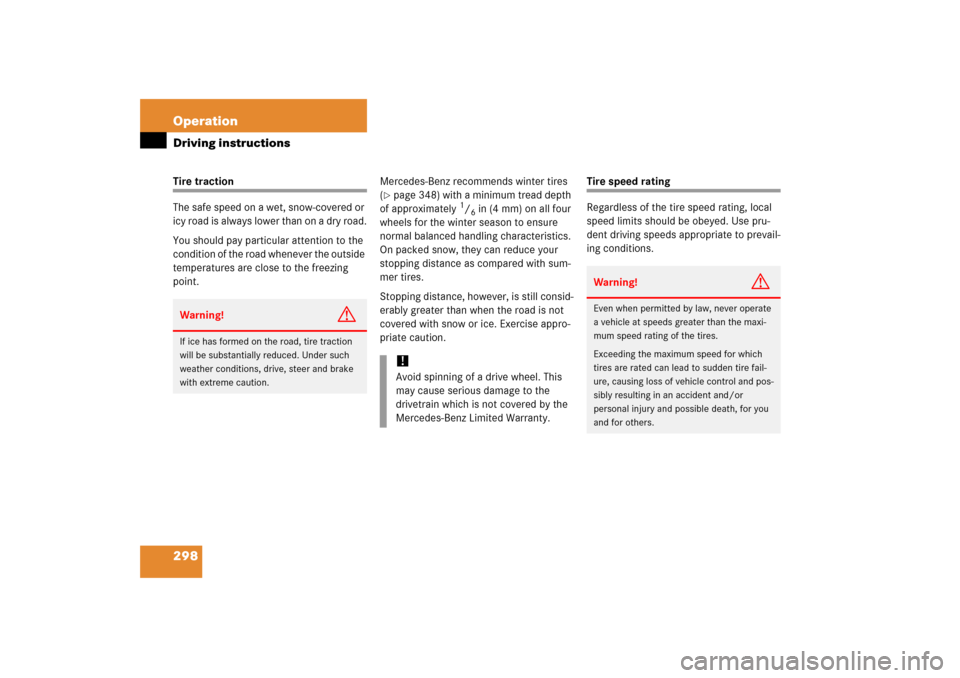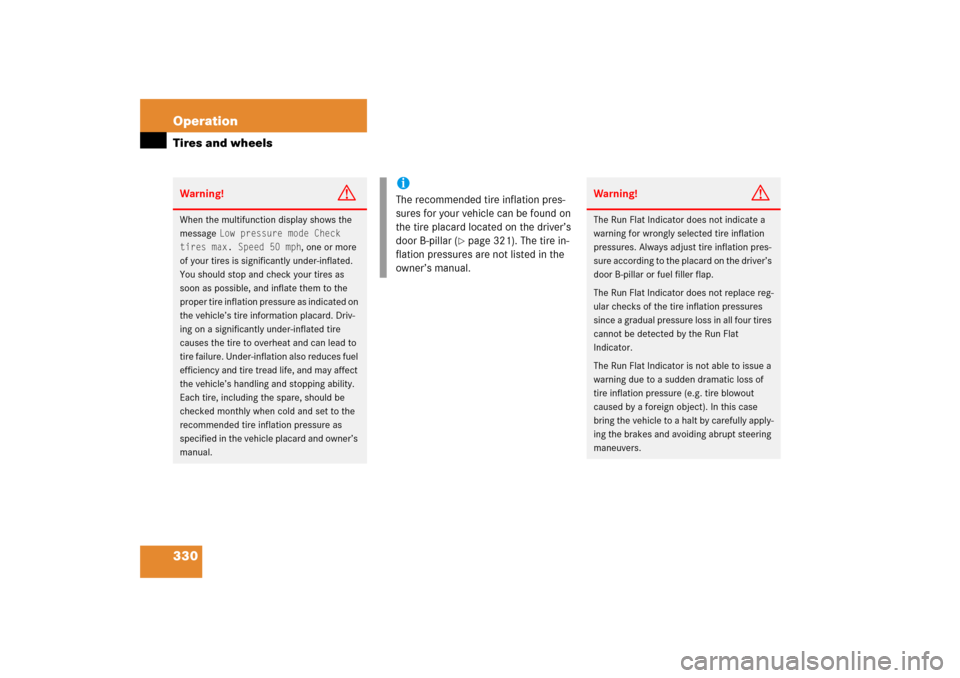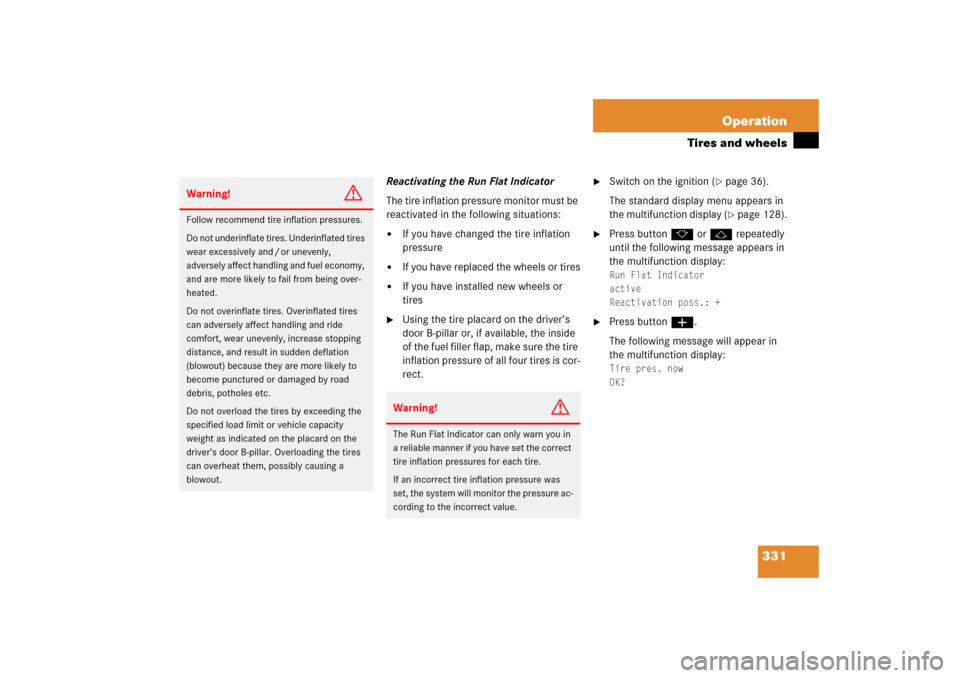Page 299 of 481

298 OperationDriving instructionsTire traction
The safe speed on a wet, snow-covered or
icy road is always lower than on a dry road.
You should pay particular attention to the
condition of the road whenever the outside
temperatures are close to the freezing
point.Mercedes-Benz recommends winter tires
(
�page 348) with a minimum tread depth
of approximately
1/6in (4 mm) on all four
wheels for the winter season to ensure
normal balanced handling characteristics.
On packed snow, they can reduce your
stopping distance as compared with sum-
mer tires.
Stopping distance, however, is still consid-
erably greater than when the road is not
covered with snow or ice. Exercise appro-
priate caution.
Tire speed rating
Regardless of the tire speed rating, local
speed limits should be obeyed. Use pru-
dent driving speeds appropriate to prevail-
ing conditions.
Warning!
G
If ice has formed on the road, tire traction
will be substantially reduced. Under such
weather conditions, drive, steer and brake
with extreme caution.
!Avoid spinning of a drive wheel. This
may cause serious damage to the
drivetrain which is not covered by the
Mercedes-Benz Limited Warranty.
Warning!
G
Even when permitted by law, never operate
a vehicle at speeds greater than the maxi-
mum speed rating of the tires.
Exceeding the maximum speed for which
tires are rated can lead to sudden tire fail-
ure, causing loss of vehicle control and pos-
sibly resulting in an accident and/or
personal injury and possible death, for you
and for others.
Page 331 of 481

330 OperationTires and wheelsWarning!
G
When the multifunction display shows the
message
Low pressure mode Check
tires max. Speed 50 mph
, one or more
of your tires is significantly under-inflated.
You should stop and check your tires as
soon as possible, and inflate them to the
proper tire inflation pressure as indicated on
the vehicle’s tire information placard. Driv-
ing on a significantly under-inflated tire
causes the tire to overheat and can lead to
tire failure. Under-inflation also reduces fuel
efficiency and tire tread life, and may affect
the vehicle’s handling and stopping ability.
Each tire, including the spare, should be
checked monthly when cold and set to the
recommended tire inflation pressure as
specified in the vehicle placard and owner’s
manual.
iThe recommended tire inflation pres-
sures for your vehicle can be found on
the tire placard located on the driver’s
door B-pillar (
�page 321). The tire in-
flation pressures are not listed in the
owner’s manual.
Warning!
G
The Run Flat Indicator does not indicate a
warning for wrongly selected tire inflation
pressures. Always adjust tire inflation pres-
sure according to the placard on the driver’s
door B-pillar or fuel filler flap.
The Run Flat Indicator does not replace reg-
ular checks of the tire inflation pressures
since a gradual pressure loss in all four tires
cannot be detected by the Run Flat
Indicator.
The Run Flat Indicator is not able to issue a
warning due to a sudden dramatic loss of
tire inflation pressure (e.g. tire blowout
caused by a foreign object). In this case
bring the vehicle to a halt by carefully apply-
ing the brakes and avoiding abrupt steering
maneuvers.
Page 332 of 481

331 Operation
Tires and wheels
Reactivating the Run Flat Indicator
The tire inflation pressure monitor must be
reactivated in the following situations:�
If you have changed the tire inflation
pressure
�
If you have replaced the wheels or tires
�
If you have installed new wheels or
tires
�
Using the tire placard on the driver’s
door B-pillar or, if available, the inside
of the fuel filler flap, make sure the tire
inflation pressure of all four tires is cor-
rect.
�
Switch on the ignition (
�page 36).
The standard display menu appears in
the multifunction display (�page 128).
�
Press buttonk orj repeatedly
until the following message appears in
the multifunction display:Run Flat Indicator
active
Reactivation poss.: +
�
Press buttonæ.
The following message will appear in
the multifunction display:Tire pres. now
OK?
Warning!
G
Follow recommend tire inflation pressures.
Do not underinflate tires. Underinflated tires
wear excessively and / or unevenly,
adversely affect handling and fuel economy,
and are more likely to fail from being over-
heated.
Do not overinflate tires. Overinflated tires
can adversely affect handling and ride
comfort, wear unevenly, increase stopping
distance, and result in sudden deflation
(blowout) because they are more likely to
become punctured or damaged by road
debris, potholes etc.
Do not overload the tires by exceeding the
specified load limit or vehicle capacity
weight as indicated on the placard on the
driver’s door B-pillar. Overloading the tires
can overheat them, possibly causing a
blowout.
Warning!
G
The Run Flat Indicator can only warn you in
a reliable manner if you have set the correct
tire inflation pressures for each tire.
If an incorrect tire inflation pressure was
set, the system will monitor the pressure ac-
cording to the incorrect value.